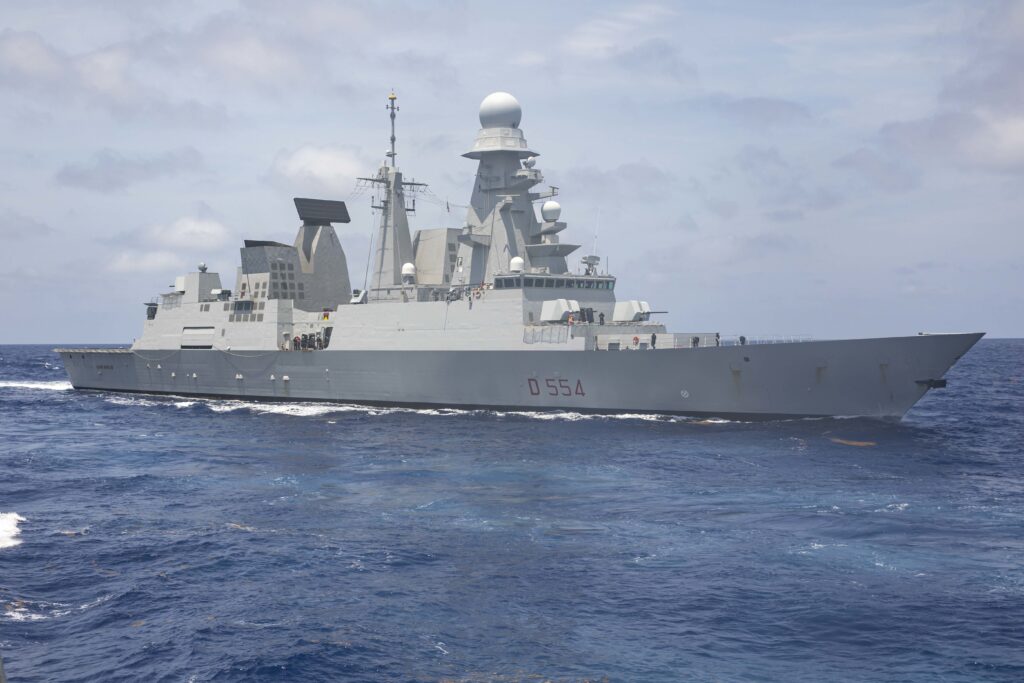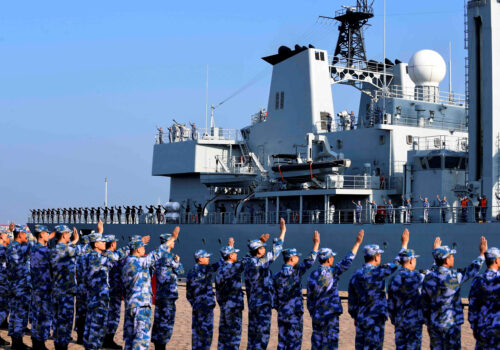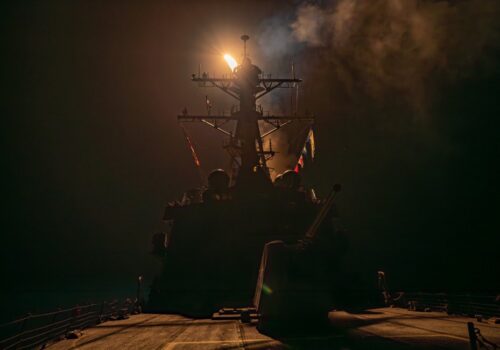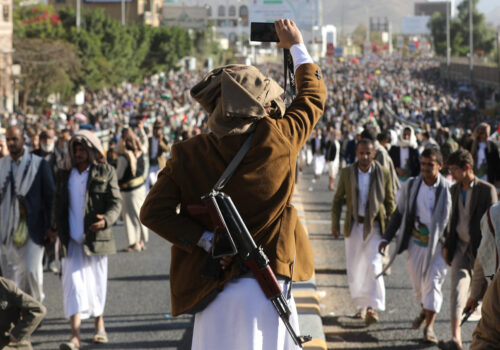On February 19, the European Union (EU) launched its own naval operation in the northwest Indian Ocean. EU High Representative for Foreign Affairs Josep Borrell called the decision to launch the mission “a fast and robust reaction to the attacks of the Houthis, who are attacking commercial ships in the region.” That is true, but the decision was also, in part, a reaction to a first round of US and UK strikes on the Houthis’ inland capabilities on January 11. The only EU country actively contributing to the strikes was the Netherlands, led by Mark Rutte, the outgoing prime minister and aspiring future NATO secretary general. While several European countries continue cooperating with Prosperity Guardian, the EU operation was set up as a sign of dissociation from the US-led operation against the Houthis, which some European governments perceive as escalatory in the fragile and tense broader regional context.
The EU operation, called EUNAVFOR Aspides (the ancient Greek word for “shields”), has initial contributions from seven member states: Belgium, Denmark, France, Germany, Greece, Italy, and Spain. It is headquartered in Greece, while Italy is in charge of its operations. Already, four multipurpose frigates are part of the mission: one each from France, Germany, Italy, and Greece. In launching Aspides, the EU seems intent on asserting European agency, with its own assets and rules of engagement, in line with its own interests rooted in confidence-building with regional states.
The shipping industry is increasingly impatient for action to protect shipping lanes, and the urgency will only increase after the March 6 attack on the cargo ship True Confidence that killed two crew members and injured six. Now the EU has to deliver. Yet, whether the new operation will help Europeans achieve their goals, strategically and in terms of perception by international and local partners, remains unclear. Already, the United States is unhappy with Europeans signaling their willingness to proceed differently from Operation Prosperity Guardian. Conversely, some in the Middle East feel that Europeans are contributing to raising military stakes in the region for their own interests.
But there might be real value in the current European approach, for regional partners as much as for the United States. With a longstanding naval, military, and diplomatic presence around the Gulf of Aden, Europe has credentials and legitimacy to engage regional players more inclusively. Although the EU’s response to the current crisis could have come sooner, the new operation will provide an impetus to step up engagement, especially given the large operation area covering the Red Sea, the Gulf of Aden, the Arabian Sea, the Gulf of Oman, and the Gulf. If Europeans want to be taken seriously and have a positive impact, they must articulate a clear vision for the basis of their future diplomatic and security initiatives, in addition to investing in adequate means to implement their initiatives.
Europeans and the US in the face of increasing militarization of the region
The Red Sea has been of strategic interest as a central corridor for global trade and connectivity ever since the opening of the Suez Canal in Egypt in 1869. Nearly 15 percent of global seaborne trade passes through the Red Sea. This includes 12 percent of seaborne-traded oil and 8 percent of the global liquefied natural gas trade, as well as 8 percent of the world’s grain trade. Around 17 percent of the world’s submarine cables pass between the Mediterranean and the Indian Ocean. The impact of the recent cable cuts in the Red Sea, affecting 25 percent of data between Europe and Asia, highlights a sometimes overlooked vulnerability while shallow waters in the sea make them more prone to damage. The southern opening of the Red Sea around the strait of Bab el-Mandeb has long been affected by piracy issues, which peaked in the 2000s. Thanks to international efforts, the threat has been significantly reduced. The safety of Bab el-Mandeb and the Gulf of Aden is now primarily affected by overlapping local, regional, and international conflicts and tensions. These include pervasive terrorist threats in Somalia and Yemen; civil wars in Sudan, Ethiopia, and Somalia; and ongoing tensions among Ethiopia, Egypt, Eritrea, and Somalia.
This entrenched instability combined with the strategic significance of the Red Sea has led to a competition for influence and militarization. Regional powers such as the United Arab Emirates (UAE), Saudi Arabia, Iran, Turkey, and Qatar are actively developing strategies to assert their influence in the Horn of Africa by establishing outposts and conducting security, economic, and diplomatic engagement. The Red Sea has also suffered from the export of rivalries between Iran and Arab Gulf countries to the maritime domain. Iran has long shown its capability to disrupt vessels operating in and out of the crucial chokehold in the Strait of Hormuz. Since a coalition led by Saudi Arabia launched military operations against the Houthis in 2015, Iran has deepened its relations with the rebel group and expanded its disruptive activities to the Red Sea, too. In 2018, the Houthis launched a severe attack on a major Saudi tanker off the Yemeni coast using an Iran-made drone boat. A year later, they launched missile and drone attacks against two major Saudi oil installations. These incidents highlighted Iranian-Houthi capabilities, pushing Saudi Arabia to seek diplomatic solutions to the conflict.
Russia and China have also taken advantage of Red Sea instability to establish footholds in the region. China’s military has expanded its first overseas base in Djibouti since its opening in 2017, while Russia concluded an agreement with Sudan in February 2023 to build a base after years of persistent attempts. Despite the presence of China and Russia, however, the United States remains the main security player in the region. It maintains a robust military presence of approximately 45,000 permanent forces, centered at the Fifth Fleet based in Bahrain, at Al-Udeid air base in Qatar, as well as in Kuwait, Saudi Arabia, the UAE, and Djibouti.
Europe has been a player in the Red Sea
Europeans have consistently reinforced their presence in and around the Red Sea. France has unique stakes due to its overseas territories in the southwestern Indian Ocean (La Réunion, Mayotte, Scattered Islands). It also has two military outposts: a joint base in Djibouti and three bases for navy, air, and land forces in the UAE. Italy, a former colonial power in the Horn of Africa, has retained strong relations and influence in the region, too. Since 2013, Italy has also had a military base in Djibouti to provide logistical support to Italian military operations in East Africa and the Indian Ocean. Moreover, European investment in maritime security is important for a country such as Denmark, home of the Maersk Group, Denmark’s largest company by revenue. Finally, since 2018, Spain has held the command of the flagship naval operation mission of the EU: EUNAVFOR Atalanta.
Atalanta was set up in 2008 with a mandate to escort World Food Program vessels heading to Somalia and fight piracy off the coasts of that country. Another existing collective European effort is the European Maritime Awareness in the Strait of Hormuz, launched in 2020. It came amid a flare-up of tensions in late 2019 caused by a series of attacks by Iran on vessels in the Strait of Hormuz, to which the United States reacted by launching a coalition called “International Maritime Security Construct” and its task force “Sentinel.” Perceiving the US move as escalatory, France initiated another coalition, composed of European nations (Belgium, Denmark, Germany, Greece, Italy, the Netherlands, Portugal, and Norway) but outside of the EU framework, with the primary objective of providing surveillance capabilities in the Gulf, the Strait of Hormuz, and a part of the Arabian Sea.
Questioning of the US-led escalatory approach in the region
The wave of Houthi attacks created major strategic dilemmas for all Red Sea stakeholders. They need to mitigate the trade and economic costs of the disruption of maritime traffic caused by the Houthis. At the same time, they are wary of the political and security costs that could come from escalating tensions in Yemen and with Iran, in particular in the context of the ongoing Gaza war. The United States, given its regional clout and facing domestic pressures to show strength against Iran and its proxies, displayed a willingness to act. Regional countries, mindful of their public opinion rattled by the events in Gaza, preferred restraint, at least in public.
Europeans asserted their positions across this spectrum. Some EU members such as Denmark, Germany, and the Netherlands ended up publicly backing the US-UK attacks. The Netherlands in particular has been providing logistical and active military support to the US strikes on the Houthis. Other European countries, such as France, Italy, and Spain, preferred to keep some distance from the US-led military operations. From the onset, both Italy and France stated that their assets in the Red Sea and surrounding areas should not be considered to be following US orders and remained under national command, with their own rules of engagement. Their fear appears to be that supporting a more kinetic US involvement over Yemen will deteriorate the security situation in the region and drag external powers into a further escalation, while potentially metastasizing the Israel-Hamas conflict.
Therefore, when the United States and the United Kingdom launched their campaign of strikes against Houthi targets, the Italian government clarified that active involvement was conditioned on parliamentary approval, while French President Emmanuel Macron declared that the move was “escalatory” and that France would continue to enforce freedom of navigation, in coordination with—but not in subordination to—US-led efforts. France’s decision balances the country’s efforts to maintain leverage, particularly in defusing tensions between Hezbollah and Israel, while preserving some space for mediation in the region. It reflects the French government’s increasing concerns about perceptions of the country in the Middle East and North Africa, as well as domestic stability, with strong popular feelings regarding the situation in Gaza and Israel. Spain was probably the most straightforward in its refusal to join US-led efforts, presenting its choice of not intervening militarily in the Red Sea as a “commitment to peace,” consistent with Madrid’s stance on the war in Gaza, which has been critical of Israel.
A new, robust EU naval mission
After initial scattered operational responses from member states, the EU launched Aspides on February 19 for a one-year mandate. Protection of shipping is the mission’s only executive task, which will have to be defined and adapted, depending on the force flow and the number of requests for protection. The main distinction with the US-UK approach is that Aspides does not envision any participation in strikes against the Houthis and will only operate at sea with an escort, patrol, surveillance, and intercept mandate.
While Europeans seek to de-escalate and assuage their Arab partners’ concerns by showing that they diverge from the US-led approach, they might end up irritating their US partner but could also inadvertently be seen as fueling escalation, thus failing to score any points vis-à-vis regional actors. Avoiding such a scenario requires a massive strategic communication effort by Europeans to explain their approach and diplomatic finesse to convince their partners. Borrell has already visited Israel, Bahrain, Saudi Arabia, Qatar, and Jordan. Several EU member state leaders and ministers have traveled extensively in these countries, as well as in Egypt. The newly appointed Greek commander of Aspides, Commodore Vasileios Gryparis, has also started reaching out to regional partners.
A paper by France, Germany, and Italy to other EU members that was leaked to the press prior to the launch of the operation pointed to two main strategic objectives: building “trust and confidence with regional Arab States” and “never entering in a confrontational mode with Iran.” The Red Sea offers a promising opportunity for constructive cooperation between European countries and Arab Gulf states, which is an EU priority. While it is in the Gulf monarchies’ interest to secure the Red Sea waterways, the priority for Gulf capitals is to avoid escalatory incidents vis-à-vis Iran. Both Saudi Arabia and the UAE feel particularly vulnerable to an Iranian reaction, which could easily target their territories, strategic assets, or critical infrastructure. The UAE and Saudi Arabia—alongside Egypt—may find it politically easier to extend their support for the EU operation rather than the US mission, given the lesser emphasis on active deterrence. The UAE and Saudi Arabia have consistently demonstrated a keen interest in internationalizing maritime security to compensate for the United States’ perceived retrenchment from the region.
Over the next year, Aspides could potentially be extended to other like-minded contributors also interested in projecting a bigger maritime security role in global strategic chokepoints. A key partner could be India, which also enjoys deep relations with the Gulf monarchies, including maritime security cooperation. Moreover, Europeans should think strategically about the consolidation phase after this immediate crisis is placated. They should carefully consider the possibility of using Aspides as a platform for sustainable deconfliction. Doing so would be another way to demonstrate complementarity with the United States, while finally responding to long-standing US pressures for more burden-sharing by Europeans.
Léonie Allard is a visiting fellow at the Atlantic Council’s Europe Center.
Cinzia Bianco is a senior fellow at the European Council on Foreign Relations.
Mathieu Droin is a visiting fellow in the Europe, Russia, Eurasia Program at the Center for Strategic and International Studies.
Further reading
Tue, Feb 13, 2024
China is testing its freeriding strategy in the Red Sea
New Atlanticist By Léonie Allard
The United States and its allies and partners must find ways to better manage Beijing’s freeriding and opportunism in the northwestern Indian Ocean.
Fri, Jan 12, 2024
Six big questions about US-led strikes against the Houthis, answered
MENASource By Kirsten Fontenrose
Ahead of authorizing the strikes, Biden had to carefully consider arguments for and against conducting strikes to limit the Houthis’ capacity to continue waging war on international shipping.
Mon, Feb 26, 2024
I’m a Yemeni minister and I believe the Houthi designation is not enough
MENASource By
The Biden administration’s decision to revoke the Houthi terrorist designation contributed to the complexity of the Yemeni crisis. To avoid replicating the same scenario, a new approach must be taken to counter the Houthis.
Image: Italian navy destroyer ITS Caio Duilio (D 554) sails alongside the Arleigh Burke-class guided-missile destroyer USS Delbert D. Black (DDG 119) before a replenishment-at-sea with the dry cargo and ammunition ship USNS William McLean (T-AKE 12), June 11, 2022. (US Navy photo by Mass Communication Specialist 3rd Class Jeremy R. Boan)



